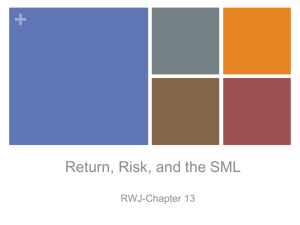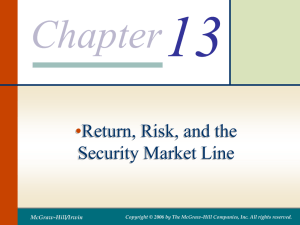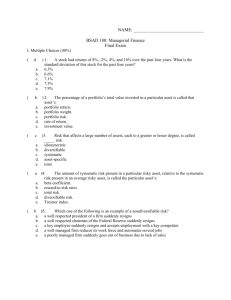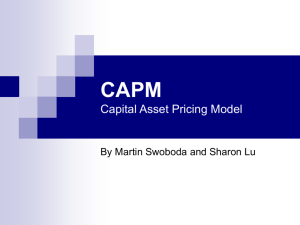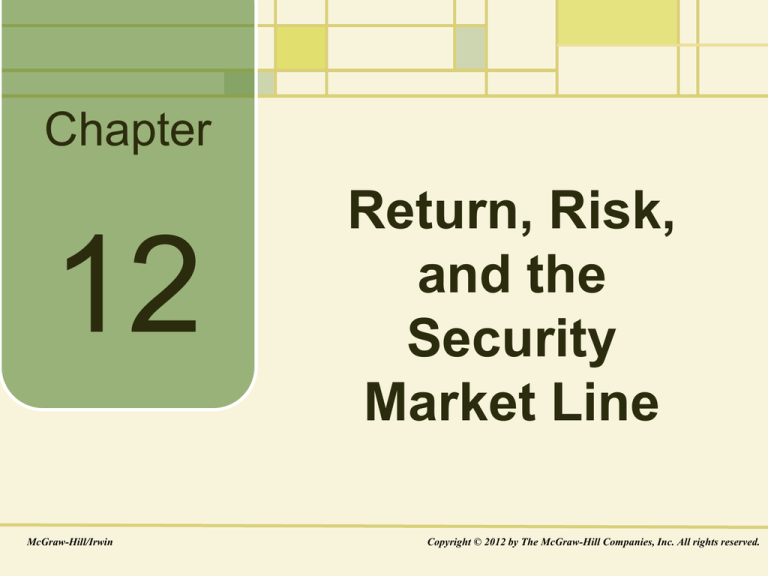
Chapter
12
McGraw-Hill/Irwin
Return, Risk,
and the
Security
Market Line
Copyright © 2012 by The McGraw-Hill Companies, Inc. All rights reserved.
Expected and Unexpected Returns
• The return on any stock traded in a financial market is
composed of two parts.
– The normal, or expected, part of the return is the
return that investors predict or expect.
– The uncertain, or risky, part of the return comes
from unexpected information revealed during the
year.
Total Return ExpectedReturn UnexpectedReturn
UnexpectedReturn Total Return - ExpectedReturn
U R - E(R)
12-2
Announcements and News
• Firms make periodic announcements about events that may
significantly impact the profits of the firm.
– Earnings
– Product development
– Personnel
• The impact of an announcement depends on how much of the
announcement represents new information.
– When the situation is not as bad as previously thought,
what seems to be bad news is actually good news.
– When the situation is not as good as previously thought,
what seems to be good news is actually bad news.
• News about the future is what really matters.
– Market participants factor predictions about the future
into the expected part of the stock return.
– Announcement = Expected News + Surprise News
12-3
Systematic and Unsystematic Risk
• Systematic risk is risk that influences a large number of
assets. Also called market risk.
• Unsystematic risk is risk that influences a single
company or a small group of companies. Also called
unique risk or firm-specific risk.
Total risk = Systematic risk + Unsystematic risk
12-4
Systematic and Unsystematic
Components of Return
• Recall:
R – E(R) = U
= Systematic portion + Unsystematic portion
=m+
R – E(R) = m +
12-5
Diversification and Risk
• In a large portfolio:
– Some stocks will go up in value because of
positive company-specific events, while
– Others will go down in value because of
negative company-specific events.
• Diversification essentially eliminates unsystematic risk,
so a portfolio with many assets generally has almost no
unsystematic risk.
• Unsystematic risk is also called diversifiable risk.
• Systematic risk is also called non-diversifiable risk.
12-6
The Systematic Risk Principle
• What determines the size of the risk premium on a risky
asset?
• The systematic risk principle states:
The expected return on an asset depends
only on its systematic risk.
• So, no matter how much total risk an asset has, only the
systematic portion is relevant in determining the
expected return (and the risk premium) on that asset.
12-7
Measuring Systematic Risk
• To be compensated for risk, the risk has to be special.
– Unsystematic risk is not special.
– Systematic risk is special.
• The Beta coefficient () measures the relative systematic risk of an
asset.
– Assets with Betas larger than 1.0 have more
systematic risk than average.
– Assets with Betas smaller than 1.0 have less
systematic risk than average.
• Because assets with larger betas have greater systematic risks, they
will have greater expected returns.
Note that not all Betas are created equally.
12-8
Published Beta Coefficients
12-9
Portfolio Betas
• The total risk of a portfolio has no simple relation to the
total risk of the assets in the portfolio.
– Recall the variance of a portfolio equation.
– For two assets, you need two variances and the
covariance.
– For four assets, you need four variances and six
covariances.
• In contrast, a portfolio Beta can be calculated just like the
expected return of a portfolio.
• That is, you can multiply each asset’s Beta by its portfolio
weight and then add the results to get the portfolio’s Beta.
12-10
Example: Calculating a Portfolio Beta
• Using Value Line data from Table 12.1, we see
– Beta for Starbucks (SBUX) is 1.15
– Beta for Yahoo! (YHOO) 0.95
• You put half your money into SBUX and half into YHOO.
• What is your portfolio Beta?
β p .50 β SBUX .50 β YHOO
.50 1.15 .50 0.95
1.05
12-11
Beta and the Risk Premium, I.
• Consider a portfolio made up of asset A and a risk-free asset.
– For asset A, E(RA) = 16% and A = 1.6.
– The risk-free rate Rf = 4%. Note that for a risk-free
asset, = 0 by definition.
• We can calculate some different possible portfolio expected returns
and betas by changing the percentages invested in these two assets.
• Note that if the investor borrows at the risk-free rate and invests the
proceeds in asset A, the investment in asset A will exceed 100%.
12-12
Beta and the Risk Premium, II.
Portfolio
Expected
Return
Portfolio
Beta
4
0.0
25
7
0.4
50
10
0.8
75
13
1.2
100
16
1.6
125
19
2.0
150
22
2.4
% of Portfolio
in Asset A
0%
12-13
Portfolio Expected Returns
and Betas for Asset A
12-14
The Reward-to-Risk Ratio
• Notice that all the combinations of portfolio expected returns and
betas fall on a straight line.
• Slope (Rise over Run):
ER A R f 16% 4%
7.50%
βA
1.6
• What this tells us is that asset A offers a reward-to-risk ratio of
7.50%. In other words, asset A has a risk premium of 7.50% per
“unit” of systematic risk.
12-15
The Basic Argument, I.
• Recall that for asset A: E(RA) = 16% and A = 1.6
• Suppose there is a second asset, asset B.
• For asset B: E(RB) = 12% and A = 1.2
• Which investment is better, asset A or asset B?
– Asset A has a higher expected return
– Asset B has a lower systematic risk measure
12-16
The Basic Argument, II
• As before with Asset A, we can calculate some different possible
portfolio expected returns and betas by changing the percentages
invested in asset B and the risk-free rate.
% of Portfolio
in Asset B
Portfolio
Expected Return
Portfolio Beta
4
0.0
25
6
0.3
50
8
0.6
75
10
0.9
100
12
1.2
125
14
1.5
150
16
1.8
0%
12-17
Portfolio Expected Returns
and Betas for Asset B
12-18
Portfolio Expected Returns
and Betas for Both Assets
12-19
The Fundamental Result, I.
• The situation we have described for assets A and B cannot persist in
a well-organized, active market
– Investors will be attracted to asset A (and buy A
shares)
– Investors will shy away from asset B (and sell B
shares)
• This buying and selling will make
– The price of A shares increase
– The price of B shares decrease
• This price adjustment continues until the two assets plot on exactly
the same line.
• That is, until:
ER A R f ER B R f
βA
βB
12-20
The Fundamental Result, II.
In general …
• The reward-to-risk ratio must be the same for all assets in
a competitive financial market.
• If one asset has twice as much systematic risk as another
asset, its risk premium will simply be twice as large.
• Because the reward-to-risk ratio must be the same, all
assets in the market must plot on the same line.
12-21
The Fundamental Result, III.
12-22
The Security Market Line (SML)
• The Security market line (SML) is a graphical
representation of the linear relationship between
systematic risk and expected return in financial markets.
• For a market portfolio,
ER M R f ER M R f
βM
1
ER M R f
12-23
The Security Market Line, II.
• The term E(RM) – Rf is often called the market risk
premium because it is the risk premium on a market
portfolio.
• For any asset i in the market:
ER i R f
ER M R f
βi
ER i R f ER M R f βi
• Setting the reward-to-risk ratio for all assets equal to the
market risk premium results in an equation known as the
capital asset pricing model.
12-24
The Security Market Line, III.
• The Capital Asset Pricing Model (CAPM) is a theory of
risk and return for securities in a competitive capital
market.
ERi R f ER M R f βi
• The CAPM shows that E(Ri) depends on:
– Rf, the pure time value of money.
– E(RM) – Rf, the reward for bearing systematic
risk.
– i, the amount of systematic risk.
12-25
The Security Market Line, IV.
12-26
Risk and Return Summary, I.
12-27
Risk and Return Summary, II.
12-28
A Closer Look at Beta
• R – E(R) = m + , where m is the systematic portion of
the unexpected return.
• m = [RM – E(RM)]
• So, R – E(R) = [RM – E(RM)] +
• In other words:
– A high-Beta security is simply one that is
relatively sensitive to overall market
movements
– A low-Beta security is one that is relatively
insensitive to overall market movements.
12-29
Decomposition of Total Returns
12-30
Unexpected Returns and Beta
12-31
Where Do Betas Come From?
• A security’s Beta depends on:
– How closely correlated the security’s return is
with the overall market’s return
and
– How volatile the security is relative to the
market.
• A security’s Beta is equal to the correlation multiplied by
the ratio of the standard deviations.
σi
β i CorrR i ,R M
σm
12-32
Where Do Betas Come From?
12-33
Using a Spreadsheet to Calculate Beta
12-34
Another Way to Calculate Beta
(The Characteristic Line)
12-35
Beta Measures Relative Movement
•
A security with a beta of 1 is expected to move, on average, with the market.
– In this case, the characteristic line would have a 45 degree angle, or a slope of 1.
– This slope means that if the market goes up, say, 3%, we expect the stock to go
up 3%.
– In mathematics, we measure slope as “the rise over the run.”
– So, if the market return is the “x data” and the stock return is the “y data”, the
slope is the beta of the security.
•
Apply this method to Figure 12.5B. What do you think the beta is?
– When the market has a 10% return, the security return is slightly less than 10%.
– The characteristic line suggests that the beta for this security is less than 1. Why?
•
You might recall from your statistics class an alternative method for estimating a “line
of best fit,” a simple linear regression.
– We regress the returns of the security (y data) on the returns of the market (x
data).
– Excel has a built-in regression function.
• The output has an estimate of the “Market Returns” coefficient, i.e., the slope.
• The highlighted “Market Returns” coefficient is the beta estimate.
12-36
Build a Beta
12-37
Why Do Betas Differ?
• Betas are estimated from actual data. Different sources estimate
differently, possibly using different data.
– For data, the most common choices are three to five
years of monthly data, or a single year of weekly data.
– To measure the overall market, the S&P 500 stock
market index is commonly used.
– The calculated betas can be adjusted for various
statistical reasons.
• The bottom-line lesson: We are interested in knowing what the beta
of the stock will be in the future, but we estimate betas using
historical data.
• Anytime we use the past to predict the future, there is the danger of a
poor estimate.
12-38
Extending CAPM
• The CAPM has a stunning implication:
– What you earn on your portfolio depends only
on the level of systematic risk that you bear
– As a diversified investor, you do not need to
worry about total risk, only systematic risk.
• But, does expected return depend only on Beta? Or, do
other factors come into play?
• The above bullet point is a hotly debated question.
12-39
Important General Risk-Return Principles
• Investing has two dimensions: risk and return.
• It is inappropriate to look at the total risk of an individual
security.
• It is appropriate to look at how an individual security
contributes to the risk of the overall portfolio
• Risk can be decomposed into nonsystematic and
systematic risk.
• Investors will be compensated only for systematic risk.
12-40
The Fama-French Three-Factor Model
• Professors Gene Fama and Ken French argue that two
additional factors should be added.
• In addition to beta, two other factors appear to be useful
in explaining the relationship between risk and return.
– Size, as measured by market capitalization
– The book value to market value ratio, i.e., B/M
• Whether these two additional factors are truly sources of
systematic risk is still being debated.
12-41
Returns from 25 Portfolios Formed
on Size and Book-to-Market
• Note that the portfolio containing the smallest cap and
the highest book-to-market have had the highest returns.
12-42





